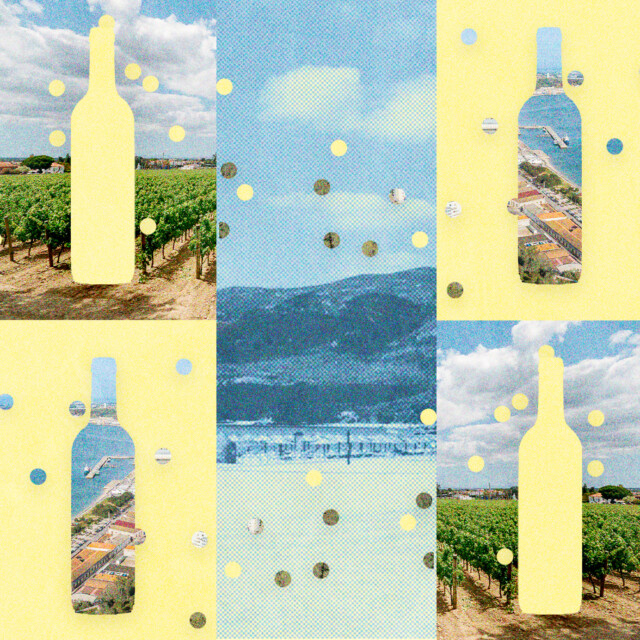With tourism now representing well over 15 percent of Portugal’s GDP, and enotourism and tourist wine consumption contributing a healthy slice of that, the sector is finally roaring back to life in post-pandemic Portugal and continuing to grow at a feverish pace.
Of course there’s Lisbon, the current darling of European capitals and epicenter of Portugal’s tourism surge. Yes, there’s so much for visitors to adore within its sun-splashed embrace, and the stunning views south across the Tejo Estuary are dreamy all by themselves. Ironically though, most folks — industry pros included — often don’t realize that they’re literally staring out at one of Portugal’s cherished local wine destinations: Setúbal. It’s right there!
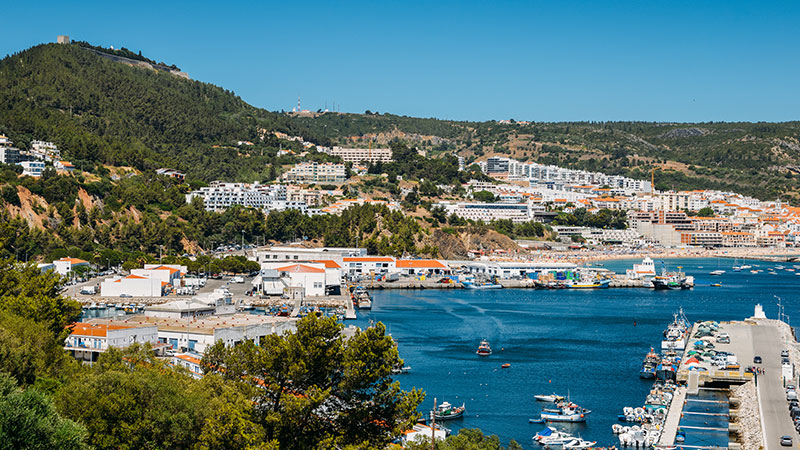
Most of the explosive growth in enotourism has understandably been claimed by the marquee regions: Douro/Porto, Alentejo, and Vinho Verde. However, requiring only a cheap rental car and a short 30–45 minute drive across the bridge, overlooked Setúbal’s countless charms are within easy reach for those Lisbon visitors in the know.
What to Drink in Setúbal
Moscatel de Setúbal
It’s a quick hop over the bridge into the heart of the Setúbal Peninsula, and a high priority on this low-maintenance road trip has to be the sweet and sassy tipple of the region: Moscatel de Setúbal.
This locally celebrated member of the Portuguese fortified trifecta — port and Madeira being the others — is chronically and tragically ignored outside the country. Lewis Kopman, of N.Y.-based importer Grossberg/Kopman Selections, agrees. “Setúbal, in my mind, is one of the most underrated dessert wine regions in the world,” he says. “The wines combine the saline minerality and savory nuances of Madeira, yet with a core of fruit that is more akin to port.” On the other hand, international anonymity keeps this treasure remarkably affordable compared to its famous siblings.
Most examples are based on ancient Mediterranean workhorse Muscat of Alexandria — known here as Moscatel Graúdo — and come in a variety of age statements. Younger versions exude tropical and floral notes with an underlying salty whisper. Editions that see extended barrel aging (frequently 20 years or more) offer up darker toffee, nut, and savory spice tones in addition to the sweet, vibrant fruit core.
The rarer Moscatel Roxo (row-shoe), which Kopman calls “one of the world’s true vinous treasures,” is produced from a darker-hued mutation of Moscatel Galego (Muscat à Petits Grains). This elusive beauty packs in more intensity and structure than Graúdo, offering up a special treat for those informed enough to hunt down a bottle.
Setúbal’s Delicious Dry Bottlings
The region’s sweet nectar is the obvious star, but the supporting cast of table wines occupying this sand-and-limestone paradise is also well worth the trip. The dry-focused Palmela DOC is tucked within the greater Península de Setúbal regional designation, and both equally offer serious bottlings as well as easy charmers.
Aside from the ideal soils, it’s the climate tightrope Setúbal walks — between the cool, misty ocean to the west and the hotter Alentejo interior — that is critical to the balance, depth of fruit, and poise that these wines can deliver. “Feel this breeze?” says José da Mota Capitão at his revered Herdade do Portocarro, “It’s always here, and it keeps the grapes dry.” Capitão, like so many other winemakers of the region, appreciates just how fortunate he is to produce in this unique slice of Portugal.
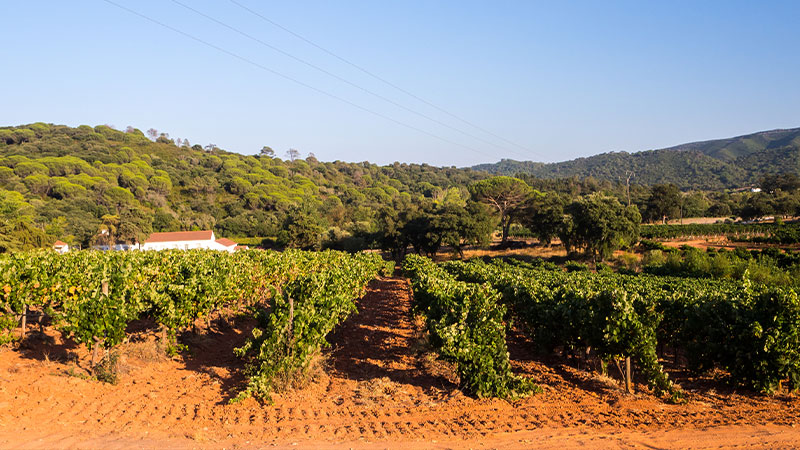
The native Castelão variety — found in gnarled old vineyards and frequently referred to here by its local Setúbal nickname “Periquita” — is Portugal’s answer to the heritage-vine Petite Sirah plantings of California. And like its distant cousin, quality examples age extraordinarily well. Conveniently, older vintages aren’t hard to come by and are easy on the bank account.
While Castelão is the red icon of the region, other indigenous varietal bottlings and old-vine blends prove more than worthy. Additionally, foreign guests — especially Bordeaux stalwarts Cabernet Sauvignon and Merlot — can shine here.
When it comes to white wines, the aforementioned Moscatel is also produced in dry renditions. The aromatically flamboyant variety boasts rounded texture, complex fruit tones, and perky acidity — just the right combination for a balanced, expressive pour. A range of other native white grapes and international guest varieties feature across the region, and the local winemakers masterfully employ them in a spectrum of refreshing and flavor-packed blends.
Notable Producers in Setúbal
(Contact for visit appointments)
Herdade do Portocarro
A tiny but mighty operation producing breathtaking dry table wines with both native and international varieties. Cult quality and a local cult following — but without the cult price.
Horácio Simões
Small, highly regarded, and down to earth, this old-school producer is best known for its marvelously complex sweet Moscatel bottlings. The dry wines are also superb.
José Maria da Fonseca
A major force in Portugal’s wine industry since the 19th century, JMF offers a diverse range of labels across the price and style spectrums. Well worth a visit for a taste and tour through the historic property.
Quinta do Piloto
Produces characterful expressions of both sweet and dry styles. In addition to a memorable visit and tasting, bookings can be made to stay in the quinta guest quarters.
Bacalhôa
In operation for over a century with multiple projects across Portugal, this producer’s flagship property offers tastings paired with lavish historic surroundings and fine art.
What to Eat in Setúbal
All that “tasting” can really work up an appetite. Luckily, Setúbal specializes in some of the best local fish and cheese in the country.
Fresh Fish
The city of Setúbal itself is a winning bet, with dozens of superb mom-and-pop joints cooking up the daily catch within easy walking distance of one another along the Avenida Luísa Todi and its narrow side streets. Incredibly fresh and simple over a charcoal grill is the name of the game here. Fried cuttlefish (choco frito), a Setúbal specialty, also makes a frequent appearance on local tables. During the summer it’s sardine season; splashed with olive oil, generously salted, and charcoal grilled whole to crispy-skinned perfection, these are a nationally cherished delicacy. Wash it all down with some chilled Setúbal or Palmela branco.
Queijo Azeitão
Tangy-salty-creamy-grassy, this local DOP sheep cheese is produced with thistle instead of animal rennet. It’s a heartbreaker pairing with any of the regional wines, dry or sweet. Smear it on bread with a dollop of ubiquitous Portuguese quince marmalade.
What to Do in Setúbal
The wine and food are clearly excellent, but that’s not where this road ends. Mountains, castles, and beaches are all immediately accessible.
“Big Sur” of Portugal
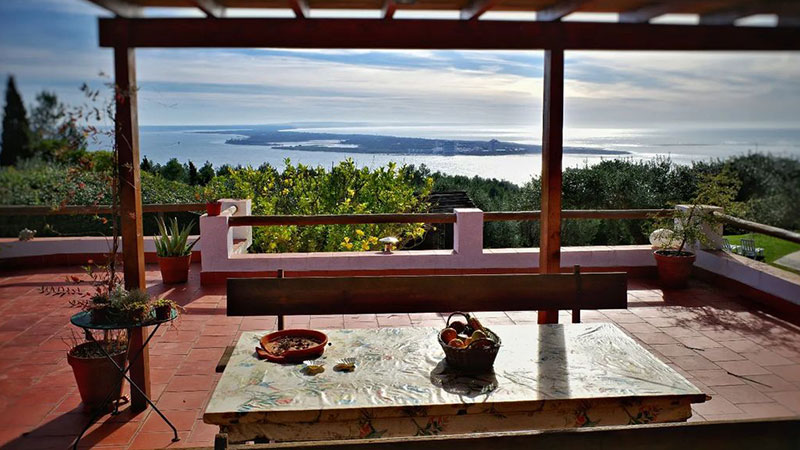
Experience jaw-dropping views and dizzying heights along the towering spine of the Serra da Arrábida. The N379-1 route, snaking between the city of Setúbal and the charming getaway town of Sesimbra, is one of Portugal’s most breathtaking scenic drives. Delightfully unique accommodations — complete with converted windmill options — like Há Mar Ao Luar can be found perched on the edge of this natural park just a quick mile up the hill from downtown Setúbal.
Medieval Stuff
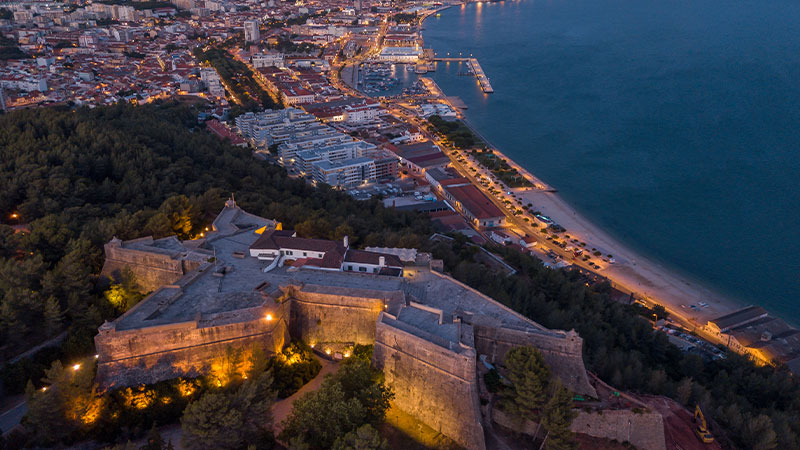
Both Castelo de Palmela and Forte de São Filipe, each with its own magical hilltop vista, provide an inspiring fix for any rampart peeper. Looking for the royal treatment overnight? The beautiful Castelo de Palmela also doubles as a hotel.
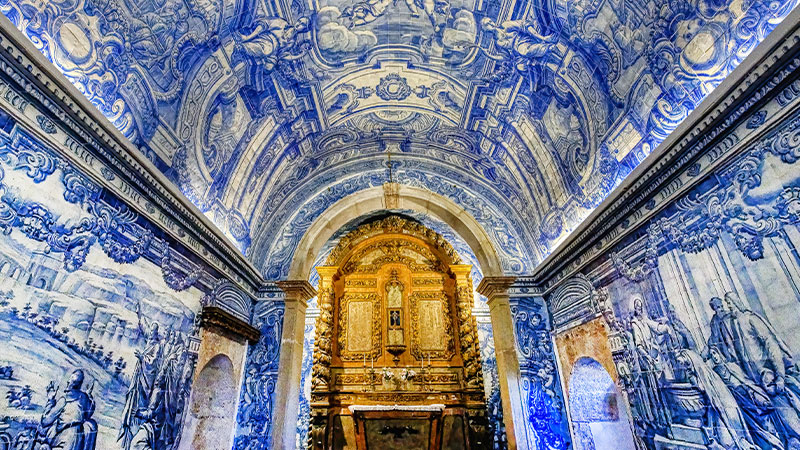
Hit the Beach
Conveniently, a long row of warm, sandy praias stretches down Costa da Caparica on the peninsula’s western edge. Generously pocked with beach bars, restaurants, and surf schools, this string of pearls has options galore for any speed or preference. Nothing ties the bow on an excursion quite like wine on a beach.
